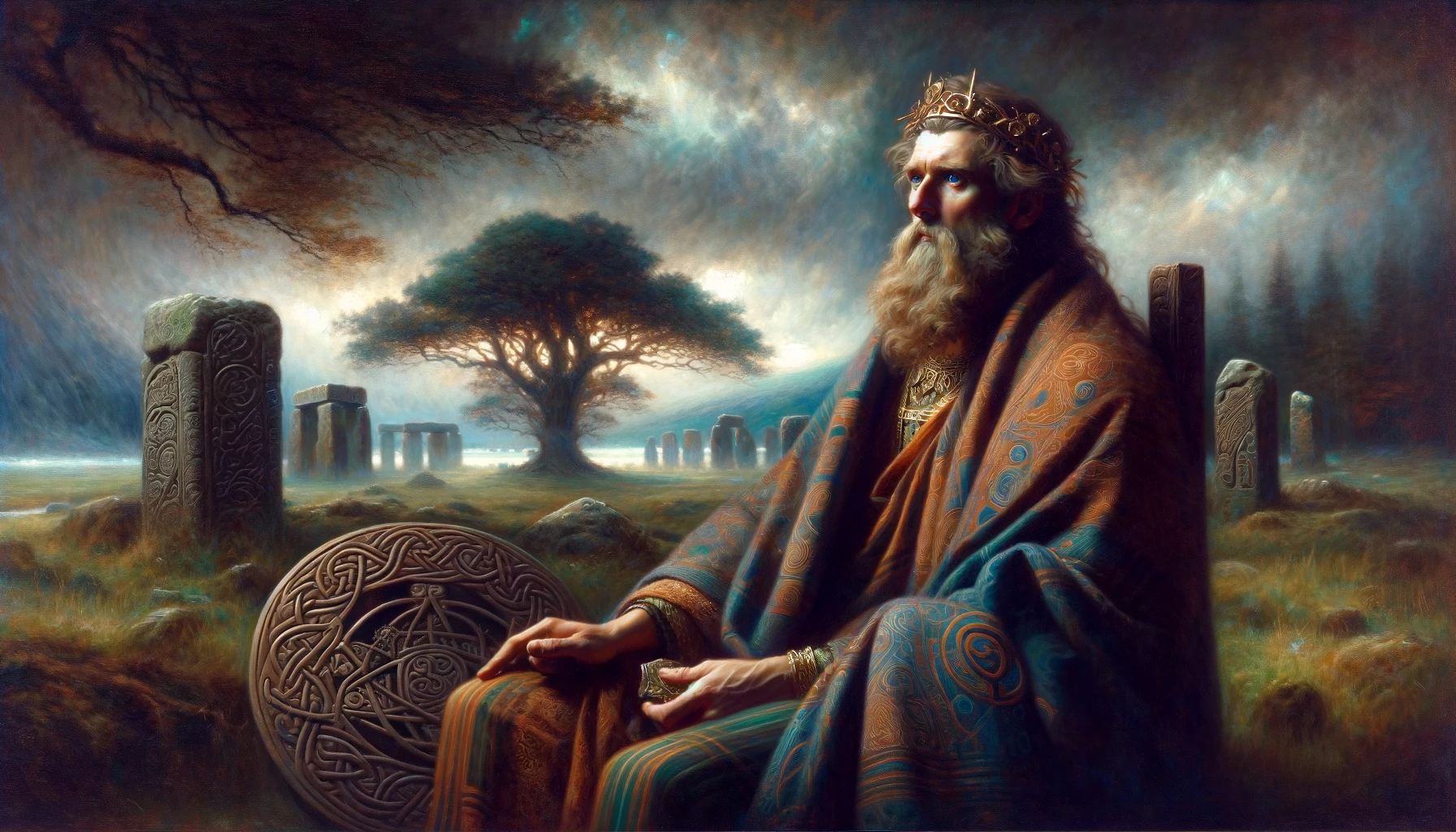Taliesin, a legendary figure in Welsh mythology and literature, was a renowned Brittonic poet believed to have lived during the 6th century AD in Sub-Roman Britain. While much of his work has been preserved in the Middle Welsh manuscript, the Book of Taliesin, the historical accuracy of his existence and compositions remains debated.
In 1960, Ifor Williams suggested that eleven of the medieval poems attributed to Taliesin could date back to the 6th century, possibly originating from a historical figure named Taliesin. These poems often praise King Urien of Rheged and his son Owain mab Urien, indicating Taliesin’s association with their courts. Additionally, Taliesin is said to have served as a court bard to King Brochfael Ysgithrog of Powys and his successor Cynan Garwyn.
Several events mentioned in Taliesin’s poems, such as the Battle of Arfderydd around 573 AD, are also documented in other historical sources. Furthermore, interpretations of Taliesin’s works suggest that he and King Urien may have been Christian adherents to the Latin observance of Easter.
Legend and medieval Welsh poetry often refer to Taliesin as “Taliesin Ben Beirdd,” meaning “Taliesin, Chief of Bards.” He is esteemed alongside other renowned poets like Talhaearn Tad Awen, Aneirin, Blwchfardd, and Cian Gwenith Gwawd in texts such as the Historia Brittonum and Y Gododdin.
In Welsh folklore, Taliesin’s legend is rich and varied. He is said to have been adopted as a child by Elffin, son of Gwyddno Garanhir, and prophesied the death of Maelgwn Gwynedd from the Yellow Plague. Over time, he became a mythical hero, associated with figures like Bran the Blessed and King Arthur.
Biography of Taliesin
Taliesin’s life is shrouded in mystery, with sparse details available. The earliest mention of him appears in Saxon genealogies appended to manuscripts of the Historia Brittonum dating back to 828 AD. Taliesin is listed among five poets who lived during the time of Ida of Bernicia, a mid-6th century ruler, and a British chieftain named (O)utigirn, known as Eudeyrn in Modern Welsh.
The credibility of this information is supported by Aneirin, another of the five poets mentioned, who is renowned as the author of Y Gododdin, a series of elegies commemorating the men of the kingdom of Gododdin who died fighting the Angles at the Battle of Catraeth around 600 AD.
Taliesin’s authorship of odes dedicated to King Urien of Rheged, who died around 550 AD, is widely accepted. These poems mention locations like the Eden Valley and reference an enemy leader named Fflamddwyn, likely identified as Ida or his son Theodric. Taliesin also praised Cynan Garwyn, king of Powys, and his predecessor, Brochwel Ysgithrog.
Legends recorded in the Book of Taliesin suggest that Taliesin’s early patron was Elffin ap Gwyddno, the son of Gwyddno Garanhir, a lord of the lost land Cantre’r Gwaelod in Cardigan Bay. Taliesin defended Elffin and satirized his enemy, Maelgwn Gwynedd, shortly before Maelgwn’s death around 547 AD. Additionally, the Latin-Breton Life of Iudic-hael mentions Taliesin visiting the monastery of Gildas at Rhuys in Brittany.
According to Welsh Triads, Taliesin had a son named Afaon, described as a great warrior who likely met a violent death, possibly in Lothian. Taliesin’s grave is a subject of folklore, with legends placing it near the village of Tre Taliesin near Llangynfelyn, known as Bedd Taliesin. However, this site is actually a Bronze Age burial chamber, and the village of Tre-Taliesin was named after the burial chamber in the 19th century, although legends tracing Taliesin’s grave date back to the 17th century.
Legendary accounts of his life
Legendary accounts of Taliesin’s life abound, with various versions offering different narratives. One notable legend is found in the Hanes Taliesin, which recounts his origin as Gwion Bach ap Gwreang, a servant of the sorceress Cerridwen. Gwion accidentally gains the gift of enlightenment intended for Cerridwen’s son, Morfran, and transforms into various forms to escape her wrath. Eventually, he is reborn as Taliesin, the foster-son of Elffin ap Gwyddno, who names him “Taliesin,” meaning “radiant brow.”
According to these legends, Taliesin prophesies the death of King Maelgwn Gwynedd at the age of 13, earning him renown. He is raised at the court of Elffin in Aberdyfi, where he demonstrates his exceptional abilities as a bard and seer.
Later interpretations of Taliesin portray him as a shamanic figure, capable of channeling divine inspiration known as the Awen. This perspective is reflected in the poetry attributed to him, which suggests a deep connection to nature and the cosmos.
In some accounts, Taliesin is depicted as a bard at the court of King Arthur, although historical evidence places him in the last half of the 6th century, slightly before the time of Arthur. Nonetheless, he is often associated with Arthurian legends and figures like Bran the Blessed.
Another legend, attributed to the 18th-century literary forger Iolo Morganwg, claims that Taliesin was captured by Irish pirates as a youth and later became a prominent bard in the court of Elffin, eventually chronicling his victories in battle.
These legendary accounts contribute to the rich tapestry of Welsh folklore surrounding Taliesin, depicting him as a figure of wisdom, prophecy, and poetic inspiration.
